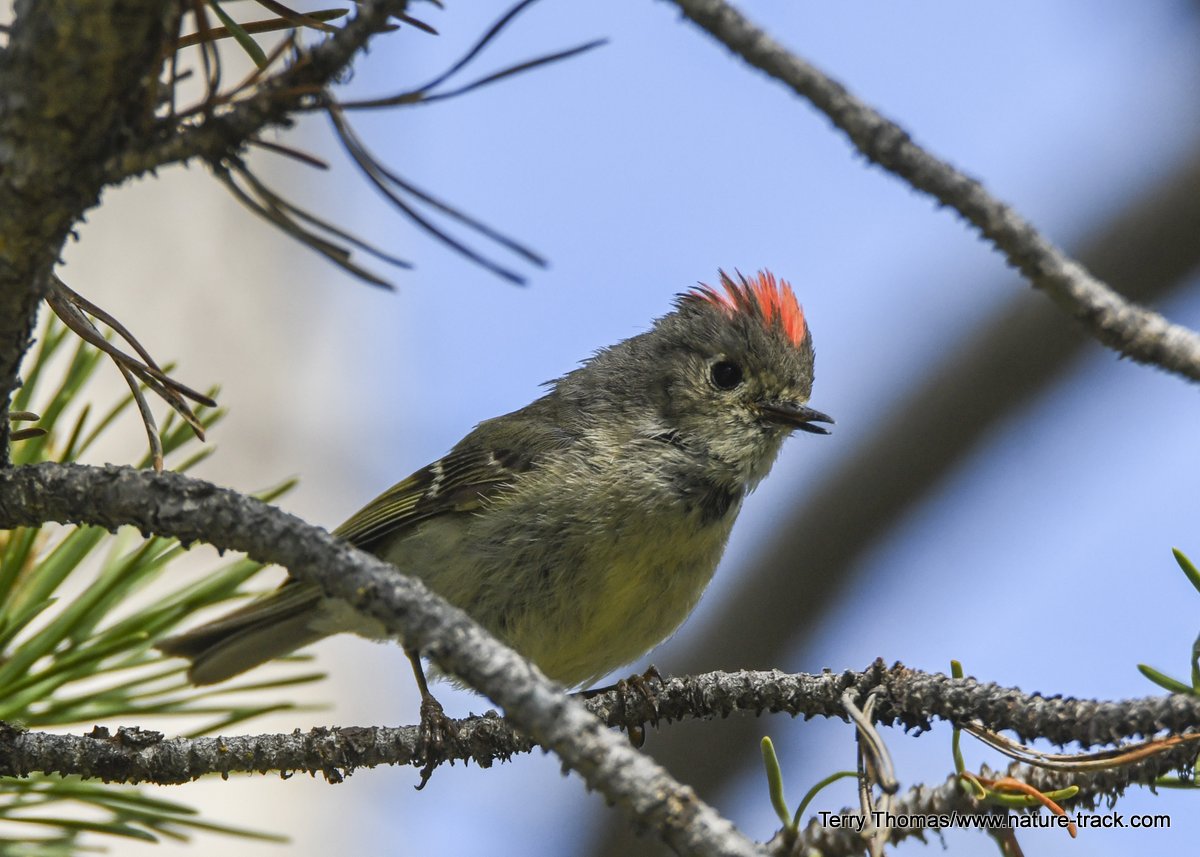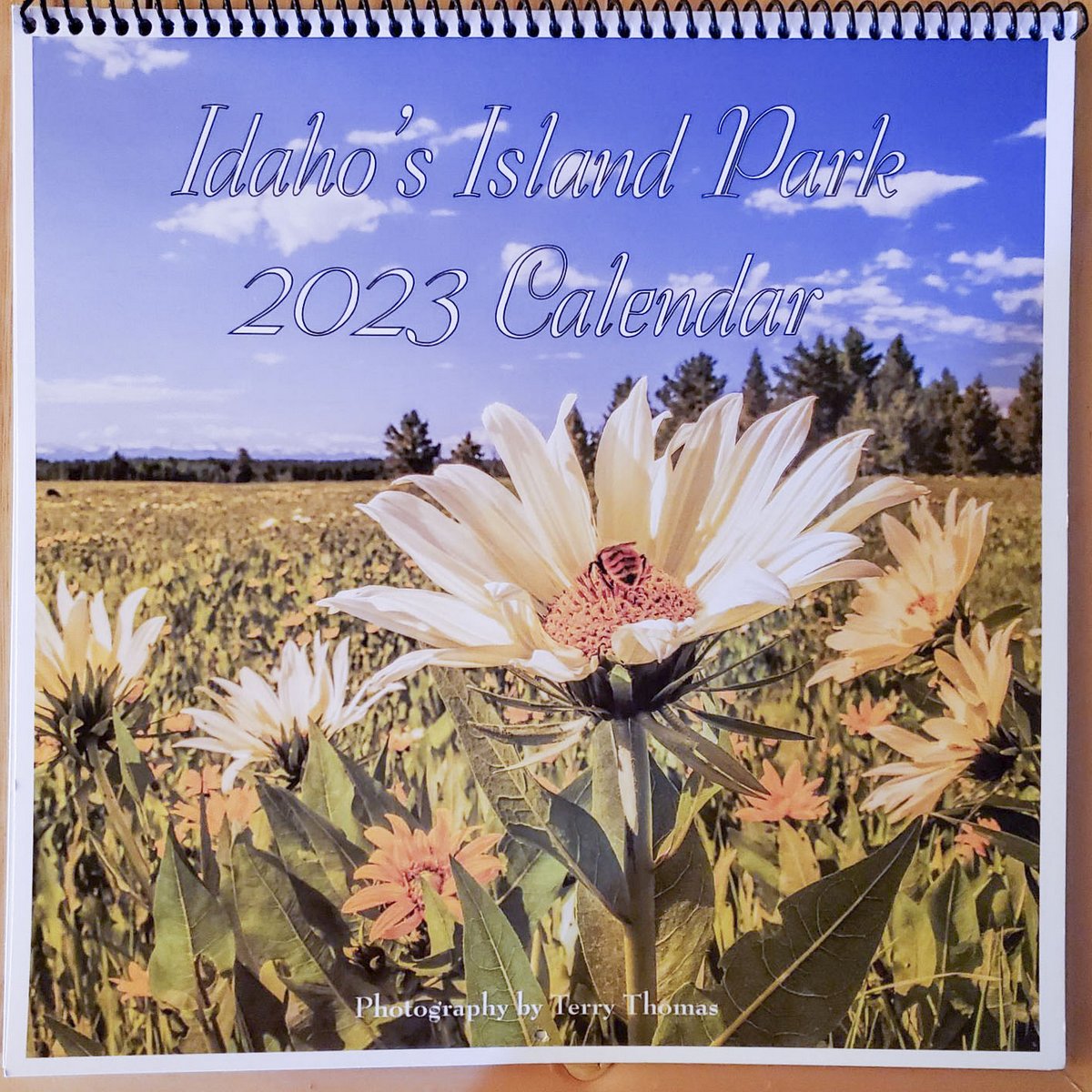Ruby-crowned Kinglet

The male ruby-crowned kinglet may display his red “crown” when agitated or trying to impress a female.
From Florida to Texas to Arizona and north to Alaska, there is one tiny bird that never fails to delight us. Most recently, we have been seeing them along the Big Springs Nature Trail in Island Park where we are fortunate enough to have numerous breeding pairs. This little bird, only four inches long, is the ruby-crowned kinglet, so named for the ruby red feathers on top of the male’s head and, presumably, for their Napoleon-like attitude—despite their small size, they seem to think that they should rule the forest.
If you are not a serious birdwatcher, you may not have even realized that there is such a thing as a ruby-crowned kinglet. Not only are these birds tiny, smaller than a chickadee, but they tend to live high up in spruce and pine forests. If the trees are tall enough, the female will construct her tight hanging nest 40 to 60 feet above the ground.
Because they nest so high in trees, little is really known about their brood rearing. Males and females stick together for about two months during the breeding/brood rearing season and the female may lay from five to twelve half-inch-long eggs in a single nest. Nests require constant maintenance and are designed to stretch as the brood grows.
Despite the energetic movement of these birds, they can be hard to see. They hunt in and among the thick branches of conifers and deciduous trees where just about any invertebrate they can catch is on the menu. This hunting keeps them endlessly circling around trunks, hanging under branches and hopping among the thickest stems. They are fast too, and seldom stay in one spot for long, making it hard to get binoculars on them before they are off again. Motion may give away their presence, but you still have to identify them.
One other thing can betray their presence and that is their song. For such a small bird, the music they make is surprisingly loud. It is a melodious sound described as, “an excited musical chattering.”
This little bird seems nervous and is almost constantly flicking its wings, a behavior that is a helpful diagnostic. It is a gray-green above, pale below and sports a white eye-ring that is often wider in the front and back than it is on top and bottom. It has a bold white wing stripe bordered on behind with black. Wing feathers often appear to have a yellow tinge and there may be some faint yellow near the tail. As previously noted, the male has the ruby crown, one that is usually hidden from view. If he becomes agitated, for example when another male enters his territory, he may raise his crown to its full splendor.
When that red crown is not on display, the ruby-crowned kinglet may be a bit difficult to distinguish from another common tiny bird, Cassin’s vireo. However, the vireo seems to have a larger rounder white eye ring and has two white wing bars separated by a black band. Their song is described as, “a series of phrases”, not melodious at all.
There are few birds that we are happier to see, wherever we are, than the ruby-crowned kinglets. Whenever we see a feathered rocket or catch a glimpse of the perpetual wing motion, we take the time to re-acquaint ourselves with these tiny wonders of the bird world.
Help Idaho Wildlife
When we traveled across the state in October 2017, we visited most of the Idaho Department of Fish and Game wildlife management areas. Most of the vehicles we saw using the wildlife management areas did not have wildlife plates. Buying wildlife plates is a great way for non-hunters and hunters alike to support wildlife-based recreation like birding.
C'mon folks, let's help Idaho's wildlife by proudly buying and displaying a wildlife license plate on each of our vehicles!
See below for information on Idaho plates. Most states have wildlife plates so if you live outside Idaho, check with your state's wildlife department or vehicle licensing division for availability of state wildlife plates where you live.
And tell them that you heard about it from Nature-track.com!

Wildlife License Plates
Great news! as of 2024, there are three NEW designs for license plates. They still are bluebird, cutthroat trout and elk, but they are beautiful.
Idaho Wildlife license plates provide essential funding that benefits the great diversity of native plants and wildlife that are not hunted, fished or trapped—over 10,000 species or 98% of Idaho’s species diversity. Game species that share the same habitats (such as elk, deer, antelope, sage-grouse, salmon, trout) also benefit from these specialty plates.
No state tax dollars are provided for wildlife diversity, conservation education and recreation programs. Neither are any revenues from the sale of hunting or fishing licenses spent on nongame species. Instead, these species depend on direct donations, federal grants, fundraising initiatives—and the Idaho Wildlife license plates.
Both my vehicles have Bluebird Plates. I prefer the bluebird because the nongame program gets 70 percent of the money from bluebird plates, but only 60 percent of the money from elk and trout plates - 10 percent of the money from elk plates supports wildlife disease monitoring and testing programs (to benefit the livestock industry) and 10 percent from cutthroat plates supports non-motorized boat access.
Incidentally, in 2014, the Idaho Legislature denied the Department of Fish and Game the ability to add new plates or even to change the name of the elk and cutthroat plates (very specific) to wildlife and fish plates, a move that would have allowed for changing images occasionally and generating more revenue. It would seem that they believe that we Idahoans don't want a well funded wildlife program.
I think it is time we let the Legislature know that Idahoan support wildlife funding and that we would like to see these generic plates come to fruition.
The 2023 Island Park Calendar is one of a kind. Almost 12 inches square, printed on extra heavy stock and with a spiral binder that allows the calendar to lay flat against a wall, it is a keepsake with photos worthy of framing. I know as I just heard that one of them was framed and used as a retirement gift for a federal employee. If you, or someone you know has ties to Island Park, this is the perfect gift. Order one today by using the Contact Us page. We can accept Venmo.


"WOW. What a phenomenal piece you wrote. You are amazing." Jennifer Jackson
That is embarrassing, but actually a fairly typical response to my nature essays. Since The Best of Nature is created from the very best of 16 years of these nature essays published weekly in the Idaho Falls Post Register (online readership 70,000), it is a fine read. It covers a wide variety of topics including humorous glimpses of nature, philosophy, natural history, and conservation. Readers praise the style, breadth of subject matter and my ability to communicate complex and emotional topics in a relaxed and understandable manner.
Everyone can find something to love in this book. From teenagers to octogenarians, from the coffee shop to the school room, these nature essays are widely read and enjoyed.
Some of the essays here are my personal favorites, others seemed to strike a chord with readers. Most have an important message or lesson that will resonate with you. They are written with a goal to simultaneously entertain and educate about the wonderful workings of nature. Some will make you laugh out loud and others will bring a tear to the eye and warm your heart.
Readers Write:
"You hit a home run with your article on, Big Questions in Nature. It should be required reading for everyone who has lost touch with nature...great job!" Joe Chapman
"We enjoyed your column, Bloom Where Planted. Some of the best writing yet. The Post Register is fortunate to have your weekly columns." Lou Griffin.
To read more and to order a copy, click here or get the Kindle version
Copies are also available at:
Post Register
Island Park Builders Supply (upstairs)
Barnes and Noble in Idaho Falls
Harriman State Park, Island Park
Museum of Idaho
Valley Books, Jackson Wyoming
Avocet Corner Bookstore, Bear River National Wildlife Refuge, Brigham City, Utah
Craters of the Moon National Monument Bookstore, Arco, Idaho